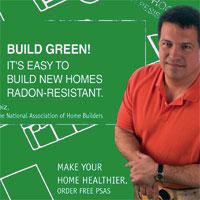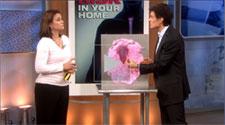Publications about Radon
General Radon Information
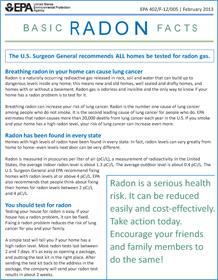
Featured Publication: Download this revised customizable fact sheet!
- Basic radon facts EPA 402/F-12/005, February 2013
There is no known safe level of exposure to radon. EPA strongly recommends that you fix your home if your test shows 4 picocuries (pCi/L) or more. If your test shows between 2 and 4 pCi/L, consider fixing.
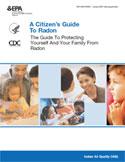
A Citizen's Guide to Radon: The Guide to Protecting Yourself and Your Family from Radon (EPA 402/K-12/002, December 2016)
This guidance offers strategies for testing your home for radon and discussions of what steps to take after you have tested, discussions of the risk of radon and radon myths. (Note: The current version reflects corrections to links and contact information.)

Consumer's Guide to Radon Reduction: How to Fix Your Home (EPA 402/K-10/005, December 2016)
You have tested your home for radon, but now what? This guidance has been specifically designed for people who have tested their home for radon and confirmed that they have elevated radon levels — 4 picocuries per liter (pCi/L) or higher. Know what to look for when selecting a qualified contractor to reduce the radon levels in your home, determine an appropriate radon reduction method and maintain your radon reduction system.

Home Buyer's and Seller's Guide to Radon (EPA 402/K-09/002, January 2009)
This booklet is intended for anyone who is buying or selling a home, real estate and relocation professionals, home inspectors and others.
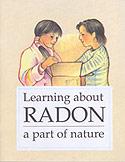
Learning About Radon A Part Of Nature
Written for Native Americans, this 18-page booklet discusses radon's place in the world, the basics on testing, and how homes can be fixed to reduce radon levels. Native Americans should contact their Tribal health department or state radon program office for more information.
See also EPA's Indoor Air Quality Tribal website.
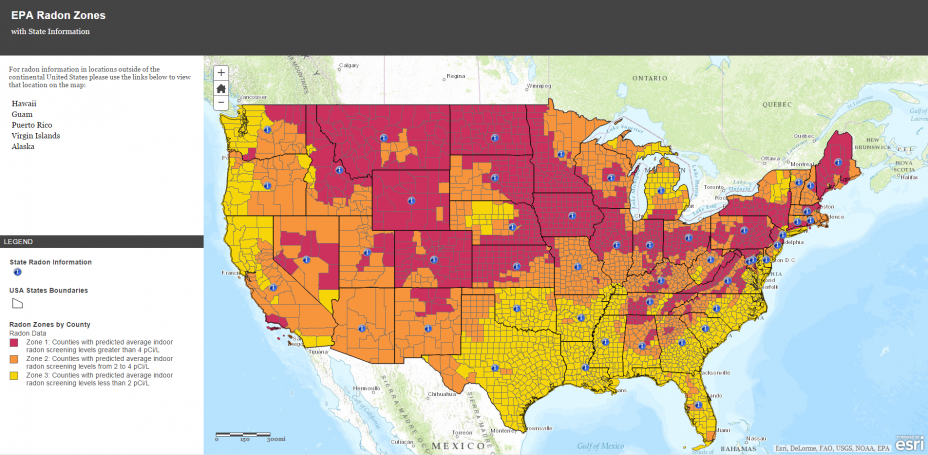
EPA Map of Radon Zones
The purpose of this map is to assist National, State and local organizations to target their resources and to implement radon-resistant building codes. This map is not intended to be used to determine if a home in a given zone should be tested for radon. Homes with elevated levels of radon have been found in all three zones. All homes should be tested regardless of geographic location.
Read more about the EPA Map of Radon Zones and find radon state contact information.
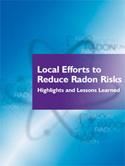
Local Efforts to Reduce Exposure to Radon
Every day in the United States someone is exposed to radon gas in their home. EPA and its partners are working to inform and educate citizens of the dangers associated with exposure to radon gas. Read about some outstanding examples and lessons learned of the successes achieved.
Radon Causes Lung Cancer: the Scientific Proof
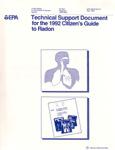
Technical Support Document for the 1992 Citizen's Guide to Radon
This document presents the wide range of technical analyses, radon risk communication research, legislative directives and other information that the U.S. EPA used to shape the policies that are set forth in the 1992 "A Citizen's Guide to Radon." The document summarizes extensive technical analyses of the data that have been gathered over the past years.
Radon - A Physician's Guide: The Health Threat With A Simple Solution (EPA 402-K-93-008, September 1993)
This booklet on radon has been developed for physicians by the EPA in consultation with the American Medical Association (AMA). Its purpose is to enlist physicians in the national effort to inform the American public about the serious health risk posed by indoor radon gas.
2003 Report: EPA's Assessment of Risks from Radon in Homes
EPA updated the Agency’s estimates of lung cancer risks from indoor radon based on the National Academy of Sciences’ (NAS) latest report on radon, the Biological Effects of Ionizing Radiation (BEIR) VI Report (1999). This report is the most comprehensive review of scientific data gathered on radon and builds on and updates the findings of the previous NAS BEIR IV Report (1988). NAS concluded that the findings of BEIR VI showed that if homeowners haven’t yet tested their homes for radon and fixed them if the levels are elevated, they should do so.
Fact Sheet: Pooling of North American Residential Radon Studies
National Cancer Institute's 2010 Surveillance, Epidemiology, and End Results (SEER) estimated US mortality numbers (PDF) (1 pp, 15 K). Exit
Media Resources for Partners and Stakeholders
EPA’s media campaigns for TV, radio and print for use by our partners, stakeholders, collaborators and advocates.
Learn more about how to view, listen to, and order radon Public Service Announcements below:
- Living Healthy & Green
- Green Sox
- Eddie's Story: Test. Fix. Save a Life
- Build Green: It's Easy to Build New Homes Radon-Resistant
- Dr. Oz Discusses: The #1 Cancer Risk at Home
- Tools and Resources for Radon Media Campaigns
Living Healthy & Green
View larger video
We want Americans to know that a big part of “living green” is breathing clean, healthy indoor air. One of the best ways to protect our families’ health is to get radon gas out of our homes. It is the environmentally responsible choice that can help reduce lung cancer.
Since radon enters homes from under the ground, living healthy and green starts from the ground up. By kicking radon out of homes every family can have safer, healthier air to breathe.
EPA developed Living Healthy & Green to educate the public about how easy it can be to kick radon out. The campaign features former NFL kicker Fuad Reveiz, now a home builder who uses radon-resistant construction and encourages others to do the same.
The campaign features TV and seven unique music genres for radio stations and MP3 players. The entire campaign is available in multiple media formats and sizes, in both English and Spanish.
Green Sox
View larger video
Radon PSAs - Green Sox Exit offers:
- 30 and 60 second TV Spots in English and Spanish
- 60 second Radio Spots tailored for different music genre
- Print Ads for Newspapers and Magazines
- Ringtones
- Pipe Stickers
- A Holiday eCard
- Web Banners
Eddie's Story: Test. Fix. Save a Life
In Eddie's Story, the winner of EPA's 2008 "Test, Fix, Save a Life" video contest, lung cancer survivor Eddie Metcalfe shares his personal story - a powerful call to action for every American home to be tested for radon. Share with your friends, and please have your home tested.
- Get the video in various media forms, get Web banners and a print ad. For Eddie's Story, you can also get a Postcard, Promotional Information (with a read me file) and a 3-Fold Card. All elements can be viewed and ordered on line at Radon PSAs - Eddie's Story Exit
Build Green: It's Easy to Build New Homes Radon-Resistant
"...The good news is you can build your customers a safer, healthier, radon-resistant home. The techniques to prevent radon from entering a home are practical and straightforward for any builder. It’s an inexpensive way to offer families a benefit that could reduce their risk of lung cancer. And it’s a smart way to build trust between you and your customer."
Fuad Reveiz, Member of the National Association of Home Builders
- Trade and Consumer Magazine Ads as well as Radio Ads are available:
- All elements can be viewed and ordered on line at Radon PSAs - Build Green! Exit
Dr. Oz Discusses: The #1 Cancer Risk at Home
For informational purposes only, check out a “discussion about Radon in Homes,” on the Dr. Oz show (aired February 10, 2011). Available on the National Center for Healthy Housing’s website. Exit
Tools and Resources for Radon Media Campaigns
The following links exit the site Exit
Builders: Building New Homes with Radon-reducing Features
Including radon-reducing features in new homes is cost-effective, and in demand by health conscious homebuyers. Some builders are installing complete fan-powered systems, especially in high radon potential areas. EPA recommends the American Society for Testing and Materials (ASTM) E1465-08 standard for radon-reducing features in new homes.
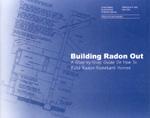
Building Radon Out: A Step-by-Step Guide on How to Build Radon-Resistant Homes
This 81-page, fully illustrated guide contains all the info you need in one place to educate home builders about radon-resistant new construction (RRNC), including: Basic questions and detailed answers about radon and RRNC; Specific planning steps before installing a system; Detailed installation instructions with helpful illustrations; Tips and tricks when installing a system, Marketing know-how when dealing with homebuyers; and, Architectural drawings.
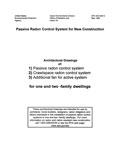
Passive Radon Control System for New Construction(EPA 402-95-012, May 1995)
These architectural drawings are intended for use by architects, home builders, designers, radon mitigators and other interested in the installation of passive radon control systems in one and two-family dwellings. Architectural drawings of: passive radon control system; crawlspace radon control system; and additional fan for active system are available.
Download an executable file (EXE)(522 K) for use with CAD programs.
Testing and Fixing Schools

Managing Radon in Schools, June 2010
As part of an effective IAQ management program, schools should test for radon to know if radon levels are elevated — and if so, reduce risks to occupants through radon mitigation. Many schools have successfully applied radon mitigation strategies to control indoor radon levels.
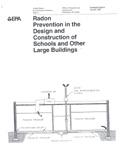
Radon Prevention in the Design and Construction of Schools and Other Large Buildings (TXT)(EPA 625-R-92-016, June 1994)
It is typically easier and much less expensive to design and construct a new building with radon-resistant and/or easy-to-mitigate features, than to add these features after the building is completed and occupied.
- See also - IAQ Tools for Schools Program
- See also - IAQ Design Tools for Schools
EPA no longer updates the follow information, but it may be useful as a reference or resource.

Reducing Radon in Schools: A Team Approach (TXT)(EPA 402-R-94-008, April 1994)
This document will assist you in determining the best way to reduce elevated radon levels found in a school. It is designed to guide you through the process of confirming a radon problem, selecting the best mitigation strategy, and directing the efforts of a multidisciplinary team assembled to address elevated radon levels in a way that will contribute to the improvement of the overall indoor air quality of the school.
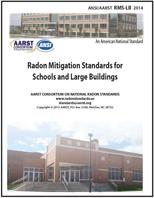
Radon Mitigation Standards for Schools and Large Buildings (RMS-LB 2014) from The American National Standards Institute (ANSI) and American Association of Radon Scientists and Technologists (AARST)
This new American National Standard addresses the complexities of properly mitigating radon in large and complicated building structures that require specialized techniques and quality assurance to address complicated building designs and specialized airflow.
Copies of RMS-LB 2014 may be purchased from AARST book store Exit, or from the American National Standards Institute store Exit.
National Radon Poster Contest
Congratulations to the winner of National Radon Poster Contest!
Current Radon Standards of Practice
Copies of the following Radon Standards of Practice may be purchased from Association of Radon Scientist and Technologists book store Exit, or from the American National Standards Institute store Exit.

Radon Mitigation Standards for Schools and Large Buildings (RMS-LB 2014)
This new American National Standard addresses the complexities of properly mitigating radon in large and complicated building structures that require specialized techniques and quality assurance to address complicated building designs and specialized airflow.
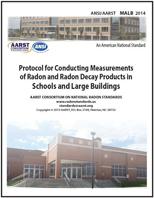
Protocols for Measuring Radon and Radon Decay Products in School and Large Buildings (MALB 2014)
This new American National Standard addresses the complexities of properly measuring radon in large and complicated building structures that require specialize techniques and quality control and assurance to address complicated building designs and specialized airflow.
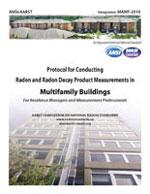
Protocol for Conducting Radon and Radon Decay Product Measurements in Multifamily Buildings (MAMF-2010).
This ANSI/AARST standard is for measuring radon levels in multifamily housing.
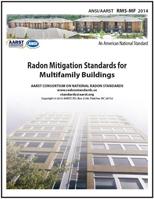
Radon Mitigation Standards for Multifamily Buildings (RMS-MF 2014)
This new American National Standard addresses the complexities of properly mitigating multifamily dwelling over four units that require specialize techniques and quality assurance.

Protocols for Measuring Radon and Radon Decay Products in Homes (MAH 2014)
This American National Standard is the first complete consensus standard and is an update of the 1993 EPA Protocol on Radon and Radon Decay Measurement in Homes.
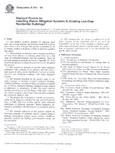
Standard Practice for Radon Mitigation Systems in Existing Low-Rise Residential Buildings*
To mitigate radon in homes, see ASTM E2121-12 Standard Practice for Radon Mitigation Systems in Existing Low-Rise Residential Buildings.

Standard: Reducing Radon in New Construction of 1 & 2 Family Dwellings and Townhouses
To control for radon in the construction of new residential homes, see Reducing Radon in New Construction of 1 & 2 Family Dwellings and Townhouses (CCAH-2013).
*American Society for Testing and Materials International, or ASTMI; an American National Standards Institute, or ANSI, approved consensus standard.
Note: As of May 2006, EPA's Radon Mitigation Standards (EPA 402-R-93-078, Revised April 1994) are no longer recommended or available.
Older Radon Standards of Practice
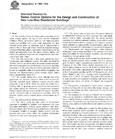
ASTM’s Standard Practice for Installing Radon Mitigation Systems in Existing Low-Rise Residential Buildings Exit *
To control for radon in new residential construction, see ASTM's Standard Practice for Radon Control Options for the Design and Construction of New Low-Rise Residential Buildings.
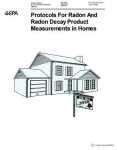
Protocols for Radon and Radon Decay Product Measurements in Homes(EPA 402-R-92-003, May 1993 *this is a corrected document number)
This document presents the U.S. EPA's technical guidance for measuring radon concentrations in residences. It contains protocols for measuring radon for the purpose of deciding on the need for remedial action, as presented in the 1992 A Citizen's Guide to Radon, and in the Home Buyer's and Seller's Guide to Radon.
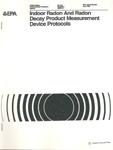
Indoor Radon and Radon Decay Product Measurement Device Protocols(EPA 402-R-92-004, July 1992)
This document provides information, recommendations, and technological guidance for anyone providing measurement services using 15 radon and radon decay product measurement methods. These protocols provide method-specific technological guidance that can be used as the basis for standard operating procedures.
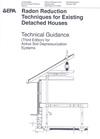
Radon Reduction Techniques for Existing Detached Houses: Technical Guidance (Third Edition) for Active Soil Depressurization Systems (TXT) (EPA 625/R-93-011, October 1993)
This technical guidance document has been prepared to serve as a comprehensive aid in the detailed selection, design, installation and operation of indoor radon reduction measures for existing houses based on active soil depressurization techniques. It is intended for use by radon mitigation contractors, building contractors, concerned homeowners, state and local officials and other interested persons. Office of Research and Development
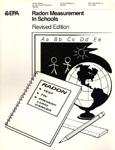
Radon Measurement in Schools (Revised Edition - Second Printing)
This report was prepared to provide school administrators and facilities managers with instructions on how to test for the presence of radon. The findings from EPA's comprehensive studies of radon measurements in schools were incorporated into these recommendations. This report superseded Radon Measurements in Schools - An Interim Report.
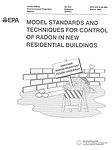
Model Standards and Techniques for Control of Radon in New Residential Buildings(EPA 402-R-94-009, March 1994)
This document is intended to serve as a model for use by the Model Code Organizations, States and other jurisdictions as they develop and adopt building codes, appendices to codes, or standards specifically applicable to their unique local or regional radon control requirements.
*American Society for Testing and Materials International, or ASTMI; an American National Standards Institute, or ANSI, approved consensus standard.
Note: As of May 2006, EPA's Radon Mitigation Standards (EPA 402-R-93-078, Revised April 1994) are no longer recommended or available.
How to Order EPA Publications
EPA's National Service Center for Environmental Publications (NSCEP)
Phone: 1-800-490-9198 (M-F from 11:00 am-3:00pm eastern)
Fax: 301-604-3408
Email: NSCEP (nscep@lmsolas.com)
Use the EPA Document Number when ordering from NSCEP. Some documents are only available as PDFs.
Contractor Reports
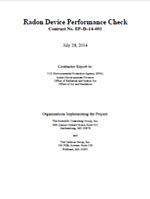
Contractor Report: Radon Device Performance Check (July 2014)
This report provides a review of radon measurement proficiency data EPA used to help determine the current proficiency of radon test devices. This report, and its release, is one thing the radon technical community is doing to help assure the public that radon test devices can be used to make mitigation decisions. Also, this report helps EPA respond to the Office of the Inspector General's report (Rpt. No. 09-P-0151), regarding oversight of radon testing device accuracy and reliability. Author: Richard Krop, Ph.D., Angana Roy, MPH.
Contractor Report: Exploratory Study of Basement Moisture During Operation of ASD Radon Control Systems (Revised March 2008)
EPA's Indoor Environments Division commissioned an Exploratory Study of Basement Moisture During Operation of ASD Radon Control Systems, under a cooperative agreement with Auburn University, Auburn, Alabama. The principal investigator was Brad Turk of Environmental Building Sciences, Inc., Las Vegas, New Mexico.
The purpose of the study was to better understand the potential moisture reduction benefits from the operation of residential radon control systems. The report contains information of interest to a wide variety of audiences. Therefore, EPA is making this contractor's reports publicly available. Because these are contractor's reports, their findings, conclusions and recommendations are those of its authors, not necessarily those of EPA. The Agency believes that this information may be useful to industry associations, standard-setting organizations, government agencies and consumers.
- Read the extended analysis May 20, 2009 | Appendix A (Correlation Matrices), B (Regression Results) and C (Moisture and Flow Data During Interzonal Flow Test Periods) May 20, 2009 | This report is only available on-line

